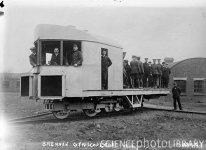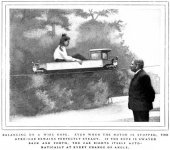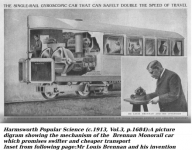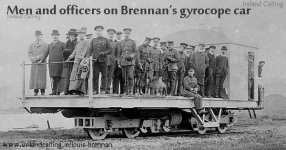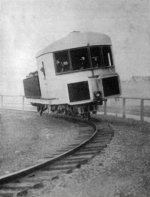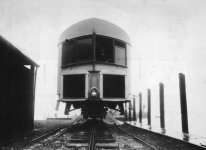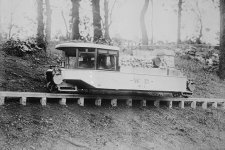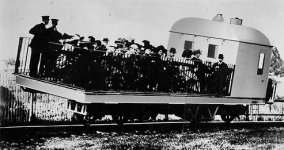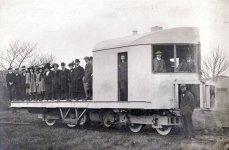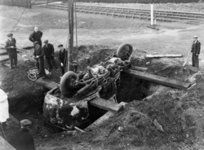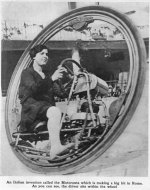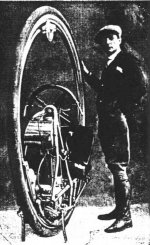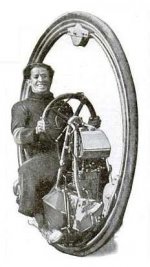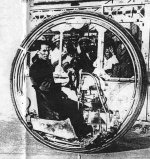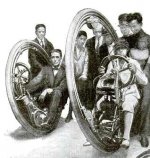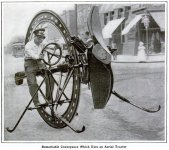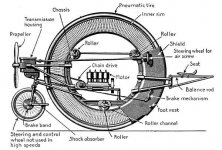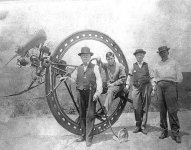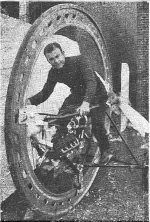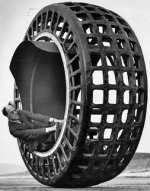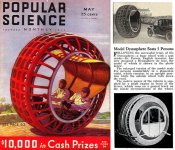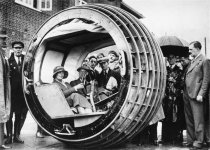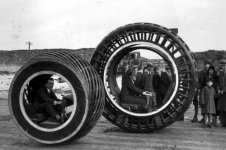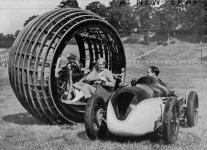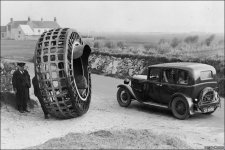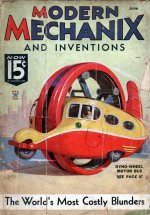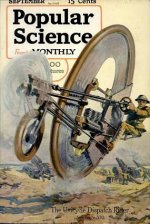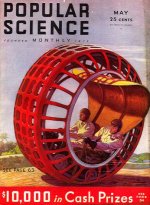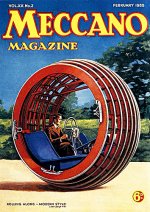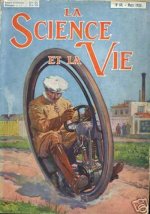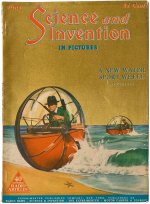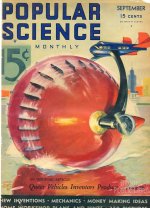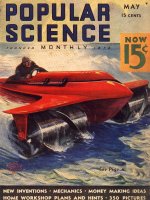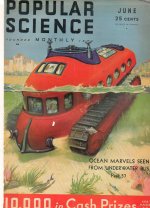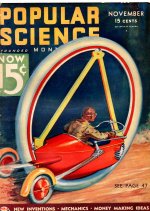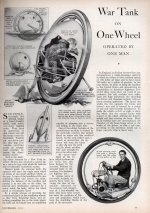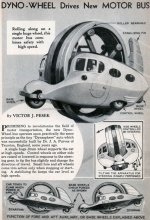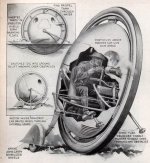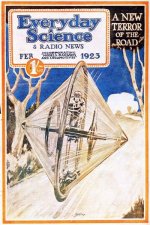Technology like the one presented in this little compilation article is not exactly hidden. As a matter of fact, the information is widely available, if you know what to look for. Early in the 20th century mechanical and engineering magazines were widely advertising these items. These gyroscopic (not only) modes of transportation were even called "The Future" at some point in time. Obviously it did not work out that way, and we are still stuck driving, and riding good old traditional cars and motorcycles. The explanation for abandoning this technology was crystal clear: not popular, and not economically feasible.
The Brennan Gyro-Monorail was developed by the Irish-born Australian inventor Louis Brennan. (1852-1932) It was 40 feet long and weighed 22 tons, and was designed to carry 10 tons. Speed on the level was 22 mph. The vehicle was balanced by two vertical gyroscopes mounted side by side, and spinning in opposite directions at 3000 rpm. Each gyroscope was 3.5 feet in diameter and weighed 3/4 of a ton each. They were enclosed in evacuated casings to reduce air-friction losses. The rotational axes were horizontal.
In the Gillingham tests the vehicle was fitted with two petrol engines. A small 20 hp unit powered the gyroscopes, drove an air-compressor (for braking?) lighted the car, and propelled it at slow speeds. A larger 80 hp engine was used for high-speed propulsion. Brennan patented the concept in 1903; see patent No 27,212, with the unsensational title "Improvements in and relating to the Imparting of Stability to otherwise Unstable Bodies, Structures or Vehicles".
The concept was originally described in fiction in 1911 "Two Boys in a Gyrocar: The story of a New York to Paris Motor Race" by Kenneth Brown, (Houghton Mifflin Co). However the first prototype Gyrocar, The Shilovski Gyrocar, was commissioned in 1912 by the Russian Count Pyotr Shilovsky, a lawyer and member of the Russian royal family. It was manufactured to his design by the Wolseley Tool and Motorcar Company in 1914 and demonstrated in London the same year. The gyrocar was powered by a modified Wolseley C5 engine of 16 - 20 hp. It was mounted ahead of the radiator, driving the rear wheel through a conventional clutch and gear box. A transmission brake was fitted after the gearbox- there were no brakes on the wheels themselves. The weight of the vehicle was 2.75 tons and it had a very large turning radius.


A reporter from The New York Times was on-hand to experience the car's official demonstration in London in May 16th of 1914, and described the ride thusly:




At the outbreak of the first World War later that year (1914), Shilovsky returned to Russia and Wolseley, having not heard from him over an extended time and assuming he'd been a casualty of the conflict, and not wanting to store the car or scrap it, buried it in the ground. There is stayed until 1938 when it was dug out of what became a train switching yard and the car was restored and put on display at Wolesley's company museum. Sadly, the car was broken up for scrap in 1948, never to be seen again.
KD: Restored in 1938, placed in a museum, and broken up for scrap in 1948. Is that right? They say it like there was only one experimental model. In the images above we can see at least two different license plate numbers OA-1941 and O-WY-88. Somebody is hiding the truth! This car appears to have been mass produced in the past. Why they need to hide the fact is a good question to find an answer for.

A second, slightly better design for motorized monowheel appeared in France made by Erich Edison-Puton in 1910 and powered by a 150 cc single-cylinder De Dion engine of 3.5 hp. Here the driver sits inside the wheel more like the position on a normal motorcycle.
As if the concept of the (motorized) monowheel itself was not dangerous enough, American inventor Clinton T. Coates got the ‘brilliant’ idea of fitting propeller-drive to one. His design, patented in 1911, features a monowheel with a push propeller at the back. The advantage of this arrangement, however, is that the propeller always pulls or pushes the wheel forwards, without relying on the weight of the rider and engine to provide reaction. There is therefore no possibility of gerbilling due to incautious acceleration, but it could still happen during braking.
Within the next few years, Alfred E. D’Harlingue – also from St. Louis – actually built a propeller-driven monowheel, which appeared on the cover of Popular Mechanics magazine in 1914. His design, however, features a front-propeller fitted directly onto the engine that can be swivelled for steering. The engine steering mechanism is fitted onto a backbone chassis running to a contra weight at the back. The driver sits quite high from the ground and almost upright with the tubular chassis running between his legs.
An article in the February 1935 issue of Meccano Magazine noted that though the Dynasphere was only at an experimental stage, "it possesses so many advantages that we may eventually see gigantic wheels similar to that shown on our cover running along our highways in as large numbers as motor cars do to-day." According to the 2007 book Crazy Cars, one reason the Dynasphere did not succeed was that "while the [vehicle] could move along just fine, it was almost impossible to steer or brake." Another aspect of the vehicle that received criticism was the phenomenon of "gerbiling"—the tendency when accelerating or braking the vehicle for the independent housing holding the driver within the monowheel to spin within the moving structure.
Sources:
KD: It appears that our past was full of various inventions which seemingly came from nowhere. Sure enough we have the inventors, and they have names. But you don't just get down to business and build the end product. There had to be that technological development curve which is nowhere to be found.
Gyroscope Train Rail Road

Well, at least it looks like those people had fun.
Some things are presented to us like it's the future...
1927 (but they started much earlier)
1910 Electrified gyroscopic monorail of Louis Philip Brennan
1927 (but they started much earlier)
1910 Electrified gyroscopic monorail of Louis Philip Brennan
The Brennan Gyro-Monorail was developed by the Irish-born Australian inventor Louis Brennan. (1852-1932) It was 40 feet long and weighed 22 tons, and was designed to carry 10 tons. Speed on the level was 22 mph. The vehicle was balanced by two vertical gyroscopes mounted side by side, and spinning in opposite directions at 3000 rpm. Each gyroscope was 3.5 feet in diameter and weighed 3/4 of a ton each. They were enclosed in evacuated casings to reduce air-friction losses. The rotational axes were horizontal.
Patented in 1903

In the Gillingham tests the vehicle was fitted with two petrol engines. A small 20 hp unit powered the gyroscopes, drove an air-compressor (for braking?) lighted the car, and propelled it at slow speeds. A larger 80 hp engine was used for high-speed propulsion. Brennan patented the concept in 1903; see patent No 27,212, with the unsensational title "Improvements in and relating to the Imparting of Stability to otherwise Unstable Bodies, Structures or Vehicles".
The concept was originally described in fiction in 1911 "Two Boys in a Gyrocar: The story of a New York to Paris Motor Race" by Kenneth Brown, (Houghton Mifflin Co). However the first prototype Gyrocar, The Shilovski Gyrocar, was commissioned in 1912 by the Russian Count Pyotr Shilovsky, a lawyer and member of the Russian royal family. It was manufactured to his design by the Wolseley Tool and Motorcar Company in 1914 and demonstrated in London the same year. The gyrocar was powered by a modified Wolseley C5 engine of 16 - 20 hp. It was mounted ahead of the radiator, driving the rear wheel through a conventional clutch and gear box. A transmission brake was fitted after the gearbox- there were no brakes on the wheels themselves. The weight of the vehicle was 2.75 tons and it had a very large turning radius.
A reporter from The New York Times was on-hand to experience the car's official demonstration in London in May 16th of 1914, and described the ride thusly:
At 3 o'clock in the afternoon the long car, with the single steering wheel set bicycle fashion in front of the shoe-shaped bonnet that covers the 16-20 horse power engine, with a dashboard form of cooler behind it and two electrical fans to induce draught of air to the radiators, came into Portman Square at a walking pace. The inventor sat beside the driver while the car made several circuits of the square, sometimes at slower than walking pace, the curves being negotiated without difficulty at that rate, and, of course, always with the vehicle on an even keel, as distinct from inclining it in the manner in which a cyclist rides around a curve. Then the car was brought to a stand, but as the gyroscope was kept in action it stood upright, and was unaffected by men stepping on to or off it or leaning against it.
KD: Restored in 1938, placed in a museum, and broken up for scrap in 1948. Is that right? They say it like there was only one experimental model. In the images above we can see at least two different license plate numbers OA-1941 and O-WY-88. Somebody is hiding the truth! This car appears to have been mass produced in the past. Why they need to hide the fact is a good question to find an answer for.
1904 Garavaglia / 1910 Erich Edison-Puton
Although the motorcycle had already been invented in 1885, it took another two decades for the first inventor to fit an engine to a monowheel. The first motorized monowheel seems to be the Italian Garavaglia machine, shown at the Milan Exposition by the House of Garavaglia in 1904. The driver in the photograph sits relaxed in his stool with the steering wheel in his hand, but the whole display seems to be balanced by a smaller stabilizer wheel on the side. A second, slightly better design for motorized monowheel appeared in France made by Erich Edison-Puton in 1910 and powered by a 150 cc single-cylinder De Dion engine of 3.5 hp. Here the driver sits inside the wheel more like the position on a normal motorcycle.
As if the concept of the (motorized) monowheel itself was not dangerous enough, American inventor Clinton T. Coates got the ‘brilliant’ idea of fitting propeller-drive to one. His design, patented in 1911, features a monowheel with a push propeller at the back. The advantage of this arrangement, however, is that the propeller always pulls or pushes the wheel forwards, without relying on the weight of the rider and engine to provide reaction. There is therefore no possibility of gerbilling due to incautious acceleration, but it could still happen during braking.
Within the next few years, Alfred E. D’Harlingue – also from St. Louis – actually built a propeller-driven monowheel, which appeared on the cover of Popular Mechanics magazine in 1914. His design, however, features a front-propeller fitted directly onto the engine that can be swivelled for steering. The engine steering mechanism is fitted onto a backbone chassis running to a contra weight at the back. The driver sits quite high from the ground and almost upright with the tubular chassis running between his legs.
1930 Dynasphere
The Dynasphere was a monowheel vehicle design patented in 1930 by Dr J. A. Purves. 1870 - 1952) Purves' idea for the vehicle was inspired by a sketch made by Leonardo da Vinci. Just watch the below video. It's short.An article in the February 1935 issue of Meccano Magazine noted that though the Dynasphere was only at an experimental stage, "it possesses so many advantages that we may eventually see gigantic wheels similar to that shown on our cover running along our highways in as large numbers as motor cars do to-day." According to the 2007 book Crazy Cars, one reason the Dynasphere did not succeed was that "while the [vehicle] could move along just fine, it was almost impossible to steer or brake." Another aspect of the vehicle that received criticism was the phenomenon of "gerbiling"—the tendency when accelerating or braking the vehicle for the independent housing holding the driver within the monowheel to spin within the moving structure.
Fun Things

Sources:
- Gyrocar - Wikipedia
- Louis Philip Brennan
- Coches Rarunos: Schilovski Gyrocar, el primer coche con sólo dos ruedas
- Dynasphere - Wikipedia
- The Schilovski Gyrocar: Turn-Of-The-Century Segway-Fighter
KD: It appears that our past was full of various inventions which seemingly came from nowhere. Sure enough we have the inventors, and they have names. But you don't just get down to business and build the end product. There had to be that technological development curve which is nowhere to be found.
Gyroscope Train Rail Road
Well, at least it looks like those people had fun.


